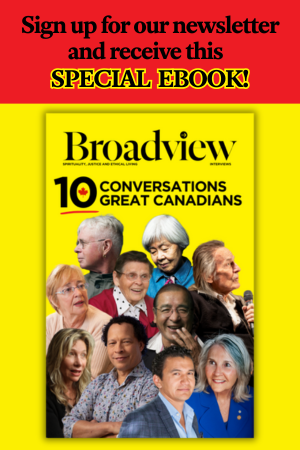Elder Patrick Etherington explains treaty through story, and one story is about a can of stew.
Along with Frances Whiskeychan, Sam Koosees, and Maurice Wesley, he is walking across treaty lands to educate and create awareness about what is happening regarding treaties under the current federal government. The group began in Cochrane, Ont., on May 7. When interviewed for this story, they had travelled nearly 3,000 kilometres to Amiskwacîwâskahikan (Edmonton).
One day on their walk, a man stops and asks Wesley about their journey. Wesley tells him, and the man asks him to wait, going back to his vehicle. Returning, he presents a can of stew, giving it to Wesley from the kindness of his heart. Telling me this story, Etherington says this stew has significant symbolism behind it, that it is the “spirit and intent for treaty.” It is in these poetic and metaphorical ways that elder Pat, from Mushkegowuk territory (Treaty 9), shares about the topic. He gets at the feeling, and the heart of it all. The rest, he says, we can “Google.”
Doing that research, I learn why this Iskapowishak Grassroots Treaty Walk’s goal is to “build grassroots alliances and come together to stop the Indigenous Rights Framework.” The framework — which is a whole host of legislation and policy from the federal government — was analyzed by Yellowhead Institute. They found that “nearly all of Canada’s proposed changes to its relationship with First Nation peoples neglect issues of land restitution and treaty obligations.”
More on Broadview: Artist calls out Indigenous stereotypes with very public work
The framework has been dubbed the “White Paper 2.0.,” because, like the scrapped White Paper would have done in 1969, many believe the result of the framework would eliminate current treaty rights and self-government policies. Wording in proposed changes is concerning. Instead of “recognizing” Aboriginal title, the legislation “may” recognize title, says Yellowhead Institute. Canada will merely “align” with the United Nations Declaration on the Rights of Indigenous Peoples rather than clearly “implementing” the articles.
Many communities are already at negotiating tables for comprehensive land claims and self-government final agreements. These discussions have been nicknamed “termination tables,” since many Nations say that in effect these changes would extinguish Indigenous rights, and First Nations would become like municipalities, or a lower “fourth” level of government. The framework was supposed to be quickly put into effect before the October federal election. Amid protests and opposition, the framework has stalled for now.
The walkers camp, or sleep in United churches and at First Nations, where they are often invited into ceremony. Helpers and walkers have joined for various sections of the trip. Others offer what they can, like stew on the side of the road. Truly embodying the hope for dialogue and relationship, Etherington asks me what I see in the story of the gift of food. I see giving of what you have, nourishing each other, being helpful, kindness, caring for one another, and deep listening. This is what Etherington wants me to know about treaty relationship. Across this land, the treaty walkers carry ceremonial pieces: their eagle staff, and a sacred bundle. Added to that bundle partway through? A can of stew.
For more of Broadview’s award-winning content, subscribe to the magazine today.















